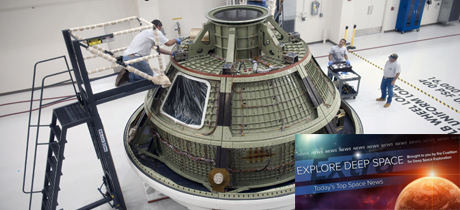In Today’s Deep Space Extra… The assembly of the first NASA Orion space capsule intended to house an astronaut crew for a journey around the moon is underway. NASA representatives will join an investigation into the troubled January 25 Ariane 5 rocket launch. NASA’s Voyager mission recordings of life on Earth score a Grammy.
Human Space Exploration
Soon humans will travel out beyond the moon
Coalition Member in the News – Lockheed Martin
Lockheed Martin (2/1): NASA’s Exploration Mission-2 (EM-2) will include astronauts for the first time as part of the second test flight of the new Space Launch System (SLS) rocket and Orion crew capsule. Engineers and technicians at NASA’s Michoud Assembly Facility near New Orleans have begun the capsule’s assembly for a mission of up to two weeks that will take the fliers around the moon and back to Earth for an ocean splashdown and recovery. The launch is planned for 2022.
‘Bringing Columbia Home’: Launch director’s book tells shuttle’s final story
Florida Today (2/1): NASA Shuttle Launch Director Mike Leinbach led efforts to recover wreckage from the shuttle Columbia, which broke apart upon re-entry 15 years ago Thursday. The seven member crew perished, following a 16 day flight. In his book, Leinbach pays tribute to an estimated 25,000 volunteers who combed a debris zone 120 miles long and 10 miles wide in East Texas and Louisiana to recover the wreckage and the astronauts in order to piece together the cause of the tragedy.
ESA publishes new estimate for Tiangong-1 uncontrolled reentry: mid-March to mid-April
GB Times of Finland (1/31): The European Space Agency is offering a new prediction on the uncontrolled deorbit of China’s once human tended Tiangong-1 orbiting space lab. The more than nine ton space station could fall back to earth between around March 18 and April 12, though where is difficult to predict. Tiangong-1’s orbit takes the hardware as far north as Chicago and New York and as far south as southern Argentina. Launched in 2011, the station hosted two crews of Chinese astronauts.
Space Science
Meteorites brought water to Earth during the first two million years
Space.com (2/2): The source of the Earth’s water continues to puzzle experts. A new study, led by an MIT scientist, suggests a large source may have been a scarce kind of meteorite, volatile rich angrites that fell onto the Earth’s surface during the solar system’s first two million years.
China launches electromagnetic satellite to study earthquake precursors
Xinhuanet of China (2/2): A satellite launched by China on Friday will demonstrate technologies that could be used to predict Earthquakes. The Seismo-Electromagnetic Satellite was launched into a sun-synchronous orbit at an altitude of about 500 kilometers that flies over regions of the Earth between 65 degrees north and south latitude.
Is space the next frontier for archaeology?
Ars Technica (2/1): A broad range of planetary science missions, many formulated by NASA and including global partners, have reached destinations as diverse as Mercury, Venus and the moon, to Titan, a moon of Saturn’s. Those spacecraft and the other machines developed for early space exploration seem destined to become significant artifacts of a new field of study, space archaeology.
Opportunity Mars rover wheels past 14 years of exploration
Space.com (2/1): NASA’s Opportunity rover landed on the red planet on January 24, 2004, with expectations of a 90 day missions. Fourteen years later, Opportunity is still exploring.
Astronomers find one of the oldest stars in the Milky Way
Universe Today (2/1): The discovery of one of the universe’s earliest stars is significant. Spanish astronomers suggest they may have discovered one of the earliest in the Milky Way — our corner of the universe. A mere 7,500 light years distant, the star catalogued as J0815+4729 shows little evidence of the heavy metallic content that denotes material made over multiple generations of star formation.
Other News
NASA to be part of Ariane 5 anomaly investigation
Space News (2/1): Arianespace’s troubled Ariane 5 launch from French Guiana on January 25 has prompted an independent investigation led by the European Space Agency’s inspector general. NASA representatives will participate. As part of its contribution to the NASA led $8.8 billion James Webb Space Telescope mission, ESA is to provide an Ariane 5 launch from the same South American spaceport. Liftoff is currently planned between March and June of 2019. Though not deployed by the Ariane 5 on the proper trajectory, two communications satellites, one with a NASA science experiment, are expected to reach geostationary orbits but take longer than planned and use more fuel than intended. The James Webb is to travel about a million miles from Earth to study the earliest galaxies and scan the atmospheres of extra solar planets for signs of biological activity.
Reprint of NASA’s Golden Record takes home a Grammy
Space.com (1/31): Quietly, perhaps, a record produced by NASA in the mid-1970s to offer greetings from a diverse population of Earth to a possible distant intelligence, received a Grammy last Sunday. The imaginative recording launched aboard NASA’s Voyager 1 and 2 missions in 1977. Both long lived spacecraft continue to transmit finding to Earth, and Voyager 1 departed the solar system in 2012.

